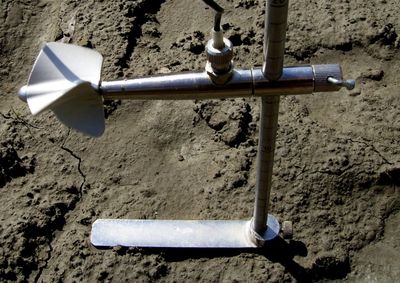Difference between revisions of "Discharge - Current meter Ott C2"
Jump to navigation
Jump to search
m (→Disadvantages:) |
|||
| (5 intermediate revisions by 2 users not shown) | |||
| Line 1: | Line 1: | ||
| + | {| align="right" | ||
| + | |[[Image:C2.jpg|right|400px|Ott C2]] | ||
| + | |} | ||
| + | |||
==Parameter to be measured:== | ==Parameter to be measured:== | ||
| − | Flow velocity ( | + | Flow velocity (discharge) |
==Method:== | ==Method:== | ||
| Line 10: | Line 14: | ||
* axle | * axle | ||
* wading rod | * wading rod | ||
| − | counting unit (e.g. Ott Z400) | + | * counting unit (e.g. Ott Z400) |
==Advantages:== | ==Advantages:== | ||
| + | * the quasi-standard; benchmark for other methods | ||
* simple no-fuss mechanics | * simple no-fuss mechanics | ||
* "sensor" (propeller) response is directly visual | * "sensor" (propeller) response is directly visual | ||
| + | * insensitive to suspended sediment, temperature, conductivity | ||
* comparatively small case including wading rods | * comparatively small case including wading rods | ||
| Line 20: | Line 26: | ||
==Disadvantages:== | ==Disadvantages:== | ||
* poor response in low velocities | * poor response in low velocities | ||
| − | * | + | * maintenance of ball bearings (oil) |
| − | * mechanical | + | * mechanical vulnerability |
| − | * no immediate calculation of discharge, no data storage | + | * no immediate calculation of discharge (except with the advanced counting units that provide these option), no data storage |
| − | |||
==What to watch out for:== | ==What to watch out for:== | ||
| Line 37: | Line 42: | ||
Projects that used the above equipment: | Projects that used the above equipment: | ||
| − | http:// | + | http://uni-potsdam.de/sesam/ |
Latest revision as of 11:37, 19 September 2016
Parameter to be measured:
Flow velocity (discharge)
Method:
propeller
Equipment:
C2:
- propellers
- axle
- wading rod
- counting unit (e.g. Ott Z400)
Advantages:
- the quasi-standard; benchmark for other methods
- simple no-fuss mechanics
- "sensor" (propeller) response is directly visual
- insensitive to suspended sediment, temperature, conductivity
- comparatively small case including wading rods
Disadvantages:
- poor response in low velocities
- maintenance of ball bearings (oil)
- mechanical vulnerability
- no immediate calculation of discharge (except with the advanced counting units that provide these option), no data storage
What to watch out for:
- submerged weeds, low velocities, piranhas
Price:
- ~ 8000 € (2008)
Links
Discharge - comparison of measurements (C2, Flowtracker, Flowsens, ADC, tracer, dipping rod)
Other related web sites:
Projects that used the above equipment: http://uni-potsdam.de/sesam/
